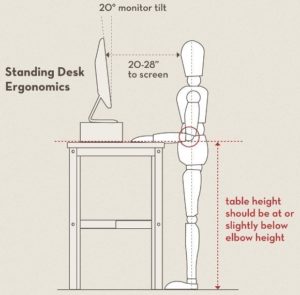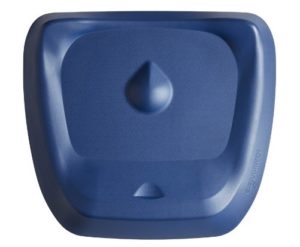Standing Desk Set-Up

By Coral Lewis, BSc., MPT, CAFCI
Because standing desks are becoming common in many office settings, we want to make sure you are getting the most out of this type of work station. There are many health benefits to be gained from a standing desk, especially those with a sit-stand option. Research shows, with sit-stand desks, a decrease in discomfort, an increase in movement, and an increase in productivity (Benden et al., 2016). One of the main benefits of a sit-to-stand desk is that it exposes your body to a variety of postures and positions that effectively diminishes the forces accumulated on muscles and joints in any one position. When purchasing a sit-to-stand desk, make sure that it is adjustable between 22-48” desk height as this range may be needed to ensure both optimal seated and standing positions. Unfortunately, some desks are advertised as sit-to-stand but sadly they are not adjustable within a standard range as noted above. This article will walk you through a series of factors that need to be considered to optimize both your standing set-up and work station utilization.
What’s the ideal sit-to-stand ratio?
As a physical therapist, I get asked this question a lot: “how much time should I be standing vs. sitting during the work day?”. We don’t have a magic formula that can be applied to everyone, but we do have research to back up these basic principles that are a good place to start.
- In the range of 1:1 or 2:1 ratio of sitting to standing seems to work well for optimizing comfort and energy levels without impacting productivity. This means that for every 1 or 2 hours standing you should sit for 1 hour (Karakolis & Callaghan, 2014). Additionally, some research indicates that you should try to alternate between sitting and standing every 30-60 minutes. Remember it’s not the standing itself that is the key – it’s the position changes throughout the day that your body really appreciates.
- Ease into it! Introducing standing to your day at the office needs to be done thoughtfully and gradually not unlike the addition of mileage to a running program or the use of a new orthotic. Your body takes time to integrate these new positions and forces. It is common to feel some fatigue and tightness in the legs, tension in the lateral hips and fatigue in the middle and low-back as your body adjusts to the new postures. If these symptoms arise, try alternating between sitting and standing more frequently to give your body a break as you adapt. To benefit from your standing desk, you should be utilizing it at least 20% of your work day but initially you should not exceed 30% of the work day in standing (Peterson, 2018). You can gradually increase the length of time standing but we caution against exceeding 1 hour of static standing before walking or sitting (Peterson, 2018) and exceeding a total of 50-60% of your working hours standing (Karakolis & Callaghan, 2014).
How do I customize my standing desk?
It is important that both the seated position and the standing position are optimized as I find one of these often takes a hit. These basic principles are a good starting point:
- Screen – The consensus for screen distance is between 18-32 inches from your face, depending on your eyesight. This is approximately an arms distance – give or take a hands width. The height of the screen should be positioned so that the top of the screen is 1” above eye level with a slight upward tilt of 10-20 degrees (note: if you use a very large screen, the top may be 3” above eye level). A good screen set-up will decrease forward head posture (Figure 1) and will eliminate excess up and downward tilting of your head while interacting with the screen.
Figure 1. http://www.chiro.org/LINKS/ABSTRACTS/Association_Between_Forward_Head.shtml
Figure 2. https://www.healthline.com/nutrition/6-tips-for-using-a-standing-desk
- Desk Height – The desk height should be adjusted so that your elbows are 90-110 degrees (Figure 2). This is one area that I commonly see mistakes in work station set-up. It is common to have the desk too low which causes a straighter arm position as you reach down to the keyboard. In turn, this puts the wrists in a compromised position when interacting with the mouse and keyboard and can lead to overuse injuries.
Does what I’m standing on matter?
Yes, yes, one-thousand times yes! There are 3 main considerations, shoes, anti-fatigue surfaces and standing posture.
- Shoes – Now that you are up on your feet for a good chunk of the day, you need to be more mindful about what shoes you are wearing. The shoes you are standing in need to have the appropriate support, cushion and width to allow for comfortable standing. If you have been prescribed orthotics or insoles you will likely benefit from wearing them in your work shoes for standing. Anti-fatigue insoles are also a great option as they allow for more cushion and a reduction in joint stresses. If you wear high heels for work, you will have to swap them out for a more supportive shoe when standing especially if they have a narrow heel and/or one that is greater than 2”. A quick test on foot wear can be “would I walk an hour + in these shoes?” if the answer is no, then consider taking them out of your work shoe rotation.
- Standing Surface – Ideally you should be utilizing an anti-fatigue rubber or cushioned surface for standing during the day and have options for changes in foot position. There are mats (Figure 3) that incorporate a cushioned and contoured surface to allow for variations in foot placement. However, what you stand on isn’t the entire picture. How you stand is a key component as well!
Figure 3. https://www.fully.com
- Standing Posture – If you’ve ever stood for a long period of time you may have noticed that some predictable compensated postures start to crop up. We naturally seek out the most energy efficient ways of standing which unfortunately involves using as little muscles activity as possible and as much ligament support as we can. This is often referred to as “hanging out on your ligament” and I’m sure you have all done it! When we stand this often takes the form of hyper-extending the knees and letting the pelvis and low back translate forward or “popping” one hip out to the side with most of the weight on one leg with a fully extended knee. Over time this can lead to injury and you would benefit from a more dynamic stance. Aim for a more active stagger-stand stance and frequently alternate what leg is behind. In this position you will keep your knees unlocked and can rock your weight forward, back and side to side to add variety. It can also be helpful to have a small foot rest that you can alternate having one foot up on as another option to maintain a more active and dynamic stance (especially if you have back pain). You are probably starting to notice a trend here – the body likes variety and standing helps to achieve that! And remember, standing is still mostly static so moving around the office is also an important way to gain movement variety.
In closing I would like to highlight that optimizing desk set-up is only part of the equation. The THREE big questions that I like to explore when addressing ergonomics is 1) Is the work station set up well for their dimensions? 2) Are they utilizing the work station optimally? 3) What other health and wellness considerations such as muscle length and muscle strength need to be considered? Careful consideration in each of these three areas will yield the best results!
There are many other fine-tuning factors that need to be considered when setting up a workstation and it would take me pages to explore all of this. This article is simply intended to get you thinking about how you stand and whether you could be standing better. If you have questions on how to optimize your sitting or standing work station or how to navigate more complex issues such as juggling multiple screens, dealing with cramped work stations, and of course injuries that impact your ability to sit or stand comfortably come see me at Stride Physio and I would love to help get you set-up well for 2019!
References:
Benden et al. 2016. Call center productivity over 6 months following a standing desk intervention. IISE Transactions on Occupational Ergonomics and Human Factors. doi:10.1080/21577323.2016.1183534.
Karakolis & Callaghan. 2014. The impact of sit-to-stand office work stations on worker discomfort and productivity: a review. Appl Ergon. doi: 10.1016/j.apergo.2013.10.001.
Peterson. March 3, 2018. Course Presentation from Professional Therapies Northwest. Office Ergonomics in the Trenches.



